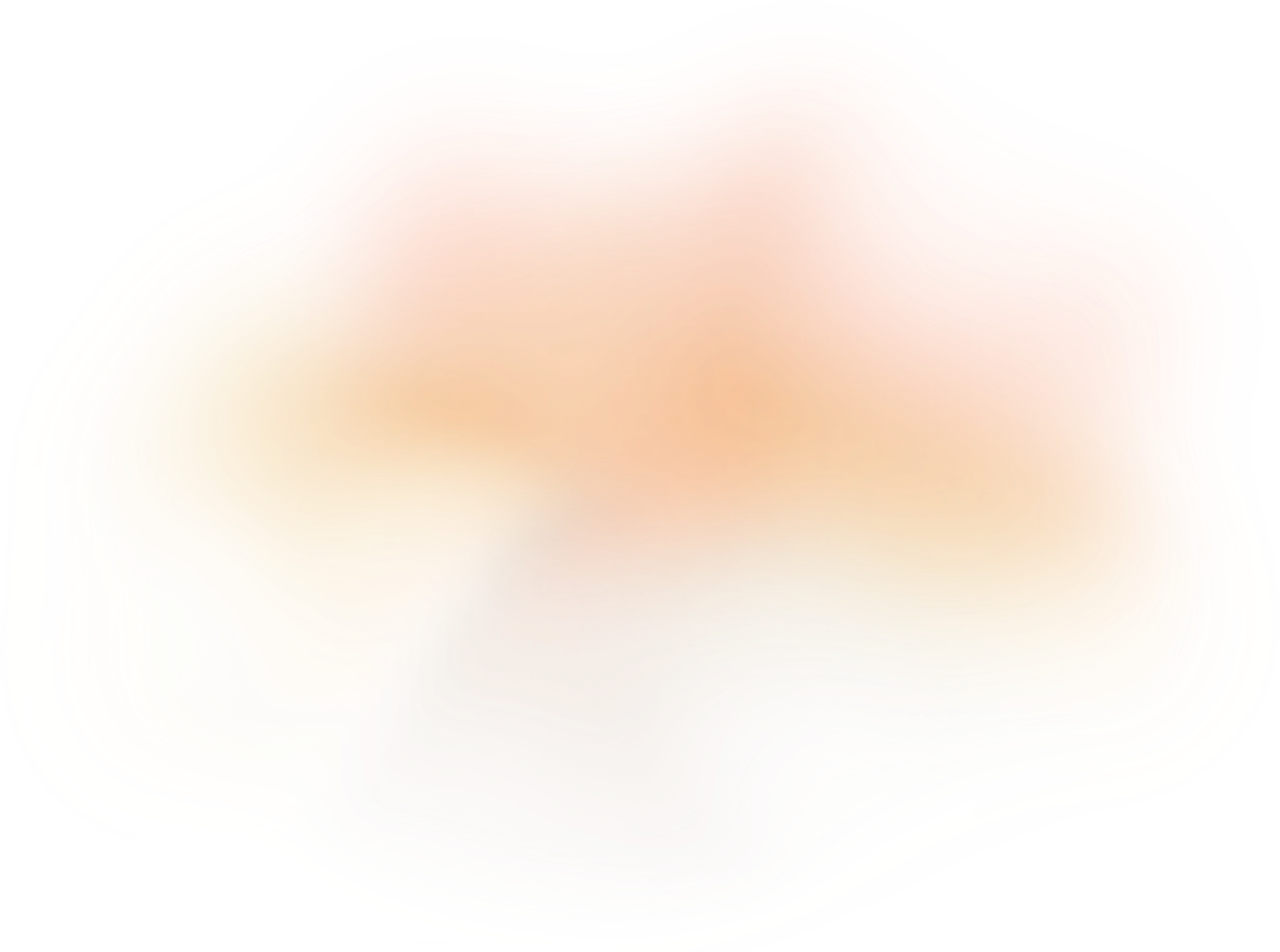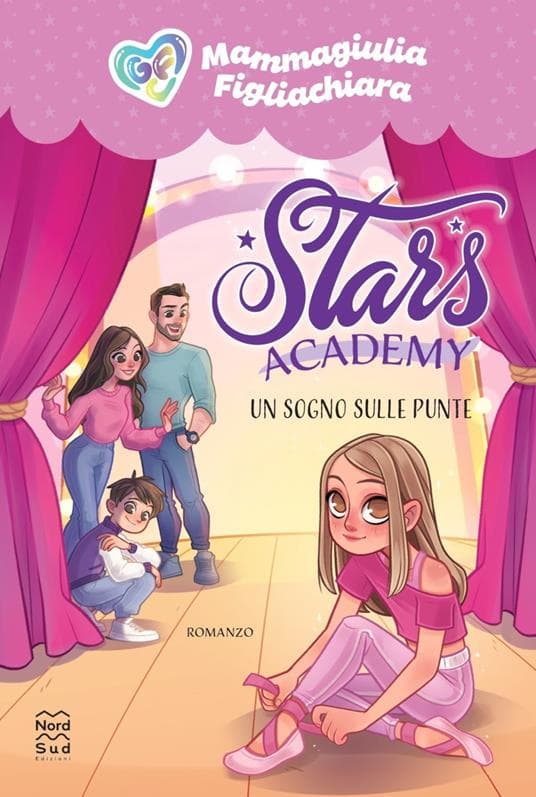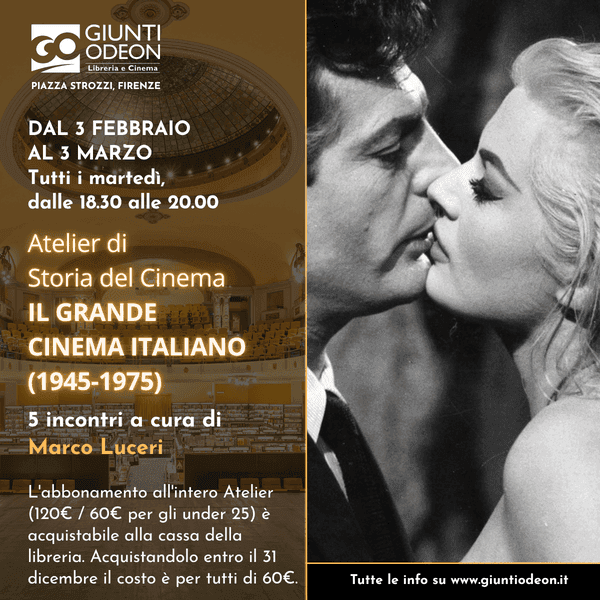
In programming

Giunti Odeon celebrates female cinema, proposing three cult films with women as the absolute protagonists. Tenacious and passionate, torn between difficult choices and passionate loves, those told in these two films are the women who stop at nothing and who are not afraid to face the pitfalls of life, without giving up their own identity.

Mammagiulia and Figliachiara are coming to Giunti Odeon for the very first presentation of their new book Stars Academy - Un sogno sulle punte (Nord-Sud Edizioni)!
A book signing session will follow.
Useful information:
-
You can get a priority pass by purchasing the book at Giunti Odeon (in-store only) up to the day of the event. Passes will be given out in time slots.
-
Those in the priority line must show their pass to the staff member in charge of checks.
-
Once the priority line has ended, anyone who did not purchase the book from us (and therefore does not have a pass) may access the book signing.
-
The number of books that can be signed depends on the authors’ availability (in any case, we recommend prioritizing the new release).
The Book
Figliachiara has a dream: becoming a ballerina. When she’s finally admitted to the exclusive Stars Academy, she's over the moon! But things aren’t quite as she imagined: the dance school has tons of rules, the classes are incredibly demanding, and some classmates seem more interested in sabotaging her than dancing together.
Between new friends, music-filled challenges, and rivalries tinged with envy, Chiara soon learns that shining on stage takes much more than talent: it requires courage, determination, and… a family ready to support you without hesitation! Luckily, Chiara knows she can always and forever count on Figliodiego, Mammagiulia, and Papàantonio.
The Authors
Mammagiulia and Figliachiara are Italian content creators, influencers, and authors. Together with Papàantonio and Figliodiego, they are one of the web’s most beloved families. Their content ranges from games and pranks to adventures. In 2022, they released their first book, La notte dei sogni (Nord-Sud).

Film History Workshop curated by Marco Luceri: Great Italian Cinema (1945-1975) - Meeting no. 1
1945-1975: this was the golden age of Italian cinema, full of masterpieces that left their mark on the entire history of film. From the ruins of war arose Neorealism, the “movement” that, with Rossellini, Visconti and De Sica-Zavattini, changed the way cinema was made and conceived forever. From the early 1950s, the revolutionary charge of Neorealism faded, becoming contaminated with popular genres such as comedy and other forms of popular cinema, passing through the golden 1960s with the affirmation of great auteur cinema (Fellini, Antonioni, Pasolini, etc.), “Italian-style comedy” and other genres (such as spaghetti westerns), until the anxieties, experiments and new sensibilities of the early 1970s. A long history in which Italian cinema reflects and reworks the enormous political, social, economic and cultural changes experienced by the country during those crucial three decades.

Film History Workshop curated by Marco Luceri: Great Italian Cinema (1945-1975) - Meeting no. 2
1945-1975: this was the golden age of Italian cinema, full of masterpieces that left their mark on the entire history of film. From the ruins of war arose Neorealism, the “movement” that, with Rossellini, Visconti and De Sica-Zavattini, changed the way cinema was made and conceived forever. From the early 1950s, the revolutionary charge of Neorealism faded, becoming contaminated with popular genres such as comedy and other forms of popular cinema, passing through the golden 1960s with the affirmation of great auteur cinema (Fellini, Antonioni, Pasolini, etc.), “Italian-style comedy” and other genres (such as spaghetti westerns), until the anxieties, experiments and new sensibilities of the early 1970s. A long history in which Italian cinema reflects and reworks the enormous political, social, economic and cultural changes experienced by the country during those crucial three decades.

Film History Workshop curated by Marco Luceri: Great Italian Cinema (1945-1975) - Meeting no. 3
1945-1975: this was the golden age of Italian cinema, full of masterpieces that left their mark on the entire history of film. From the ruins of war arose Neorealism, the “movement” that, with Rossellini, Visconti and De Sica-Zavattini, changed the way cinema was made and conceived forever. From the early 1950s, the revolutionary charge of Neorealism faded, becoming contaminated with popular genres such as comedy and other forms of popular cinema, passing through the golden 1960s with the affirmation of great auteur cinema (Fellini, Antonioni, Pasolini, etc.), “Italian-style comedy” and other genres (such as spaghetti westerns), until the anxieties, experiments and new sensibilities of the early 1970s. A long history in which Italian cinema reflects and reworks the enormous political, social, economic and cultural changes experienced by the country during those crucial three decades.

Film History Workshop curated by Marco Luceri: Great Italian Cinema (1945-1975) - Meeting no. 4
1945-1975: this was the golden age of Italian cinema, full of masterpieces that left their mark on the entire history of film. From the ruins of war arose Neorealism, the “movement” that, with Rossellini, Visconti and De Sica-Zavattini, changed the way cinema was made and conceived forever. From the early 1950s, the revolutionary charge of Neorealism faded, becoming contaminated with popular genres such as comedy and other forms of popular cinema, passing through the golden 1960s with the affirmation of great auteur cinema (Fellini, Antonioni, Pasolini, etc.), “Italian-style comedy” and other genres (such as spaghetti westerns), until the anxieties, experiments and new sensibilities of the early 1970s. A long history in which Italian cinema reflects and reworks the enormous political, social, economic and cultural changes experienced by the country during those crucial three decades.

Film History Workshop curated by Marco Luceri: Great Italian Cinema (1945-1975) - Meeting no. 5
1945-1975: this was the golden age of Italian cinema, full of masterpieces that left their mark on the entire history of film. From the ruins of war arose Neorealism, the “movement” that, with Rossellini, Visconti and De Sica-Zavattini, changed the way cinema was made and conceived forever. From the early 1950s, the revolutionary charge of Neorealism faded, becoming contaminated with popular genres such as comedy and other forms of popular cinema, passing through the golden 1960s with the affirmation of great auteur cinema (Fellini, Antonioni, Pasolini, etc.), “Italian-style comedy” and other genres (such as spaghetti westerns), until the anxieties, experiments and new sensibilities of the early 1970s. A long history in which Italian cinema reflects and reworks the enormous political, social, economic and cultural changes experienced by the country during those crucial three decades.
A place of history and beauty
Since 1922, the most beautiful films, the most distinguished guests, and the most remarkable events have taken the stage at the magnificent cinema-theatre in Piazza Strozzi, Florence. Come visit us.
Odeon, a century of cinema and culture.
A book filled with images, documents, stories, and curiosities retraces the history of one of Florence's most iconic places, from its origins to the present day. Discover more.
Exclusive benefits
With the GO Card, enjoy the benefits of Giunti al Punto bookstores and the exclusive experiences of Giunti Odeon. Coming soon.



